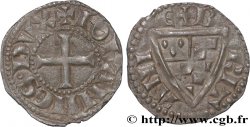Live auction - bry_481697 - HENRY III Double sol parisis, 2e type 1586 Beaucaire
You must signin and be an approved bidder to bid, LOGIN TO BID. Accounts are subject to approval and the approval process takes place within 48 hours. Do not wait until the day a sale closes to register. Clicking on "BID" constitutes acceptance of the terms of use of cgb.fr private live auctions.
Bids must be placed in whole Euro amounts only. The sale will start closing at the time stated on the item description; any bids received at the site after the closing time will not be executed. Transmission times may vary and bids could be rejected if you wait until the last second. For further information check the Live auction FAQ
All winning bids are subject to a 18% buyer’s fee.
All winning bids are subject to a 18% buyer’s fee.
| Estimate : | 400 € |
| Price : | 355 € |
| Maximum bid : | 355 € |
| End of the sale : | 31 July 2018 15:59:27 |
| bidders : | 3 bidders |
Type : Double sol parisis, 2e type
Date: 1586
Mint name / Town : Beaucaire
Metal : billon
Millesimal fineness : 319 ‰
Diameter : 26 mm
Orientation dies : 5 h.
Weight : 3,29 g.
Rarity : R3
Coments on the condition:
Ce double sol est frappé sur un flan large et irrégulier présentant quelques faiblesses de frappe. Exemplaire recouvert d’une légère patine grise portant de petites taches
Catalogue references :
Obverse
Obverse legend : + HENRICVS. III. D. G° FRN. ET. P. REX (MG) 1586, (POINT DANS LE C).
Obverse description : H couronnée entre trois lis posés 2 et 1.
Obverse translation : (Henri III, par la grâce de Dieu, roi des Francs et des Polonais).
Reverse
Reverse legend : R - .SIT. NOMEN. D[OM]INI. BENEDICTVM., (POINT DANS LE C).
Reverse description : Croix cléchée fleurdelisée.
Reverse translation : (Béni soit le nom du Seigneur).
Commentary
Stéphan Sombart et Jean Tastet ont fait le point sur les émissions des ateliers de Beaucaire et de Béziers pendant la Ligue (BSFN, avril 2002, p. 65-67) : “Le 7 juillet 1585, par le traité de Nemours conclu entre Henri III et la Ligue, les édits de tolérance religieuse étaient révoqués et le roi promettait à la Ligue d'expulser tous les Huguenots qui refuseraient de se convertir. Ce traité, enregistré au Parlement de Paris le 18 juillet et au Parlement de Toulouse le 31 juillet, allait renforcer en Languedoc une guerre civile entre deux partis déjà opposés : d'une part les ligueurs languedociens et d'autre part le parti des Politiques, dirigé par Henri de Montmorency et constitué de catholiques et protestants modérés. Henri de Montmorency, seigneur de Damville, est le fils puîné du connétable Anne de Montmorency auquel il succéda dans le gouvernement de Languedoc en mai 1563. Maréchal de France en 1566, Henri de Montmorency prend le titre de duc après le décès de son frère aîné François en 1579. En 1574 déjà, il s'oppose au roi Charles IX puis à son frère Henri III . À la suite du traité de Nemours, devenu le chef des opposants au pouvoir royal tenu en main par la Ligue, il entre à nouveau en révolte après avoir été destitué de son gouvernement de Languedoc. Refusant sa disgrâce, Henri de Montmorency continue à se comporter en gouverneur de Languedoc et procède à la fabrication de monnaies pour financer ses troupes. La Ligue en Languedoc possède l'atelier de Villeneuve-Saint-André-lès-Avignon. Henri III tente aussi de contrôler l'atelier de Montpellier en le transférant à Narbonne, ville ligueuse, mais le personnel de l'atelier composé en majorité de protestants refuse ce transfert et continue à fabriquer pour le compte d'Henri de Montmorency, mais toujours au nom d'Henri III. De son côté, Henri de Montmorency assiège Villeneuve qui refuse de lui obéir et l'atelier de Villeneuve se réfugie en sécurité dans le fort Saint-André d'où il ne sera pas délogé durant toute cette guerre civile. Devant cette détermination, Henri de Montmorency décide alors de concurrencer l'atelier de Villeneuve qui applique les ordonnances royales (qui précisent de fabriquer des doubles sols parisis à 52 au marc) et ouvre un nouvel atelier à Beaucaire en 1585 pour fabriquer des doubles sols parisis à 72 au marc, ainsi qu'il en avait déjà usé à Montpellier. En mai 1586, cet atelier de Beaucaire est transféré à Béziers où il fonctionne dès le 20, avec du personnel venu de Montpellier. Pour cette raison, il avait été supposé que les doubles sols parisis, seules fabrications de Béziers, étaient identifiés par la lettre N, différent de l'atelier de Montpellier . L'atelier de Béziers fut fermé vers le 15 septembre 1586 à la demande et moyennant 15.000 écus des maîtres de l'atelier de Montpellier auxquels il faisait concurrence, atelier lui aussi contrôlé par Henri de Montmorency. Malgré des fabrications que l'on peut supposer abondantes, les monnaies fabriquées dans ces ateliers sont rares et mal connues car les trois ateliers, Villeneuve, Beaucaire puis Béziers ont fabriqué des doubles sols parisis en 1585-1586 en utilisant la même lettre d'atelier, une R. Ce qui permet de différencier les fabrications de ces trois ateliers, en dehors d'un poids plus faible à Beaucaire puis Béziers par rapport à Villeneuve, est donc uniquement les marques de maître et de graveur ainsi que S. Sombart l’indiquait en 1997 "Ces monnaies [de Béziers] n'ont pas été mises en évidence et le différent du maître qui permettrait de les identifier reste inconnu". Cette monnaie, avec un globe crucigère et un point dans les C est attribuée à Beaucaire.








 Report a mistake
Report a mistake Print the page
Print the page Share my selection
Share my selection Ask a question
Ask a question Consign / sell
Consign / sell
 Full data
Full data















